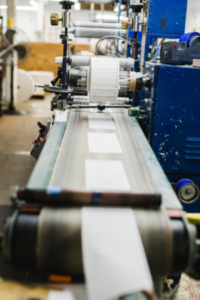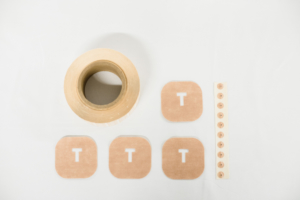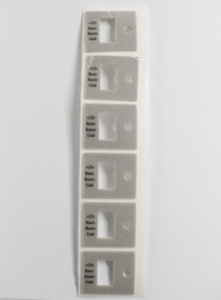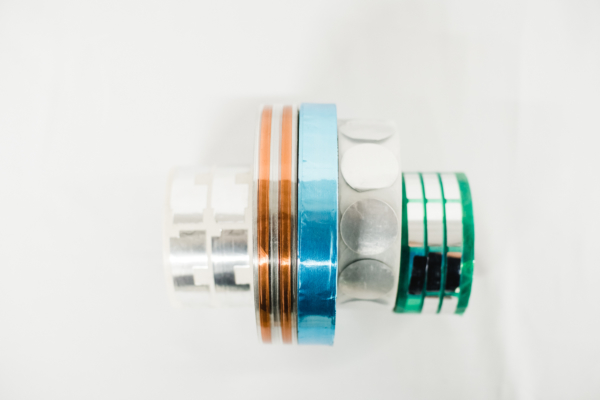What is Pattern Adhesive Coating?

Adhesives Used in Pattern Adhesive Coating
Permanent adhesives – Permanent adhesives would be used in applications like a destructive bond which would permanently destroy the material in the location of the bond. An example ups envelope.
Removable Adhesives – a removable adhesive example would be a decorative sticker or decal in which the material with the adhesive coating could be removed and re-applied
Transfer adhesives – A transfer adhesive example would be a liner with an adhesive which is made to transfer the adhesive to the final product.
Temporary adhesives – are used for pinning or temporarily bonding two materials for the manufacturing process.
Conductive Adhesives – Conductive adhesives are used to create patterns between insulating materials
Heat Transfer Adhesives – These pattern adhesives are used for heat transferred shapes and designs
There are unlimited examples of adhesive patterns and dead zones. At MCL we have the ability to engineer a solution that contains the ideal characteristics for your pattern adhesive coating needs.
Adhesive Zone and Pattern Examples:
To illustrate some of the uses for pattern adhesive coating and dead zones, here are some typical examples:
- An adhesive coated material with a smaller dead zone
- A material with a smaller adhesive zone located inside of it
- A material with a printed adhesive pattern in the form of letters or shapes
- A material with a border adhesive zone

A “T” shaped dead zone
This list describes some specific applications in which MCL has provided pattern adhesive coating and die cutting.
- Electrical insulation battery component
- K-cup top
- Food product
- Medical grade adhesive with a permanent adhesive for non-woven (bandage)
- Drill bit product packaging
- Self Sealing Envelopes
- Self Sealing Pouches

Battery Insulator island placement with adhesive dead zone
Rotary ultrasonic welding as an alternative to pattern adhesive coating
Slightly different than applying an adhesive pattern, but serving a similar function, ultrasonic welding can allow us to tack multiple material layers together to facilitate the die cutting process. Our rotary Servo press allows us to rotary ultrasonic weld materials at production speeds
We can ultrasonically weld at speed items like pouches and other containers as well as items that require a strong bond between two dissimilar substrates.
Static Electricity As An Adhesive
MCL has manufactured a variety of converted materials adjoined using static as an adhesive. When two flexible materials require ease of removal, no residual adhesive on the two components, and cost savings through elimination of a manufactured adhesive, static can be a great choice! MCL’s engineering team can spend many hours developing the perfect static solution to join the sheets at the right time in the cycle, and ensuring the bond holds during the final die cutting or packaging stage.
What is Island placement?
Island placement is a process in which we can place a material inside of a larger adhesive area, or we can place an adhesive area in a larger non-adhesive area. An example of the first type of island placement is a bandaid. An example of the second could be foil top sealed cover for a bottle or jar, with adhesive contacting the lip of the bottleneck, and the area covering the bottle mouth without.
Advantages of and Alternatives to Island Placement
Island placement allows you to apply adhesive directly to the contact area instead of flood coating the entire area and removing scrap. This method saves material and costs. It maximizes material utilization because it is an additive process as opposed to a subtractive process like flood coating. Another alternative method to island placement would be to mask or use a release lining to cover the non-adhesive surface and then to coat over the release lining and the remaining surface. Once again this method produces adhesive waste in contrast to island placement.
Pattern Adhesives and Island Placement in Label Manufacturing
Pattern adhesive manufacturing is an efficient method of manufacturing product labeling. Think of a label that covers the partial area of a product like a frying pan. The retailer wishes to show some of the surface of the pan, but wants to display brand and specifications. Pattern adhesive in this example would have the benefit of reduction of waste by only placing adhesive on the final product area, as opposed to placing an adhesive coating on the entire circular portion of the decal, and then die cutting the decal area and discarding the cut out portion.
MCL’s Technical Help & Design Assistance:
Island placement and pattern adhesive coating can be a complex process requiring tight tolerances and high volume production. We excel in creating the manufacturing solution that will deliver your product on-time and on-budget. We commonly develop small innovations that are not mechanical in nature for specific products which might improve the handling of the material and maximize efficiency. Some recent innovations include: Changing the function of a press exchanging a thin belt to a thicker belt to cut harder materials; Creating custom fixtures for machines and our laser cutter; Static cling troubleshooting, and many more. In addition to the troubleshooting and manufacturability design capabilities of our engineering team, our technology gives us an additional advantage in material converting.
A Recent Customer and Their Pattern Adhesive Challenge
A recent customer had been using an adhesive that was too aggressive so that when the part was die cut, it would rebond. In true MCL fashion, we used our expertise to identify the perfect adhesive which would only bond when and where it should. It is a regular experience for our experienced team to suggest modifications to prints to enhance the cost, manufacturability, and performance which our customers appreciate.
Technology and Production Speed Advantage in Pattern Adhesive Coating
One of the many ways this technology advantage can produce a better end product is in bonding dissimilar materials. For example, our Sysco servo press can laminate a soft foam to a liner with extraordinary accuracy. These materials can be difficult to join, as the tension must remain constant as the material is fed. The Sysco press will constantly evaluate the torque value of the servo motor as it unwinds so the tension is precisely the same when it starts the roll to when it finishes.
Our technology allows us to achieve high speed laminating and die cutting production. With our servo press, we constantly monitor each die strike for consistency to make measurable increases in efficiency and precision. These efficiency and precision increases can be drastic when compared to the capabilities of a traditional rotary press. These efficiencies are compounded when the component being laminated or die cut requires more than one process or layer. With a traditional rotary machine, the part would run through for the first process and then be re-fed for the second. With our Sysco rotary servo press we can achieve these processes continuously at production speeds.
Why Choose MCL for Pattern Adhesive Coating Services?
Our team, our technology, our turnaround times, and our drive to innovate and improve are the reasons our customers choose to work with us. We are known in the pattern adhesive manufacturing space as exceptional problem solvers, and the ones you can turn to when manufacturability is complex.


